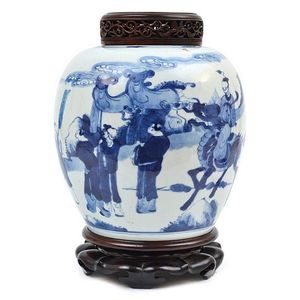Meiji Satsuma Vase with Heian Period Gathering Scene
You must be a subscriber, and be logged in to view price and dealer details.
Subscribe Now to view actual auction price for this item
When you subscribe, you have the option of setting the currency in which to display prices to $Au, $US, $NZ or Stg.
- Oviform /ovoid - The outline loosely resembling the shape of an egg.
- Circa - A Latin term meaning 'about', often used in the antique trade to give an approximate date for the piece, usually considered to be five years on either side of the circa year. Thus, circa 1900 means the piece was made about 1900, probably between 1895 and 1905. The expression is sometimes abbreviated to c.1900.
- Tortoiseshell - Tortoiseshell is a translucent material that comes from the horny carapace of a certain types of turtles, including the hawksbill turtle. It is often therefore mounted on a colour underground - often red - or inlaid with gold or silver thread, as seen in Boulle furniture.
The texture and colour nuances of the material are extremely important. Heated tortoiseshell can easily be formed into various shapes. Like other natural materials, tortoiseshell becomes more beautiful with use. In a time before plastic, tortoiseshell was widely used for small objects such as combs and powder compacts.
In 1973, the trade of tortoiseshell worldwide was banned under CITES (The Convention on International Trade in Endangered Species). Prior to importing or exporting items containing tortoiseshell a CITES permit must be obtained. Tortoiseshell items cannot be traded on Ebay.
"Faux tortoiseshell", another case of man initiating nature, is made from old-style plastics such as celluloid and cellulos and is coloured with red, yellow and brown spots to imitate the genuine article. It is commonly used in glasses frames, musical instruments and costume jewellery.
This item has been included into following indexes:
Visually similar items

A blue and white ginger jar with wooden cover and stand Kangxi period / 18th century, decorated with figurative scenes, double ring mark to base hairline and firing flaw the vase, 21.5 cm high

A Japanese Satsuma baluster vase, painted and gilded with ducks, irises, wisteria, etc. Printed marks on base. With stand. Height 25 cm

Japanese Satsuma vase. Ladies in garden decoration. Red mark to base.

A Carlton Ware 'Devil's Copse' vase, circa 1933 period, pattern 3787 attributed to Violet Elmer, shape 226. The vase jewelled with exotic and fantastic blooms and spear leaves beside a twisted tree with pendant tracery and 'Watching eyes' in enamel colours
